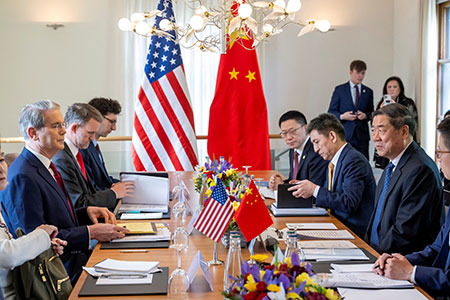
High-level American and Chinese officials convened in Stockholm on Monday for a critical third round of trade negotiations, aiming to de-escalate an economic conflict that has seen Washington impose triple-digit tariffs on Chinese imports. The US delegation, led by Treasury Secretary Scott Bessent and Trade Representative Jamison Greer, met with their Chinese counterparts, headed by Vice Premier He Lifeng, in an effort to find a path forward after previous agreements with the EU and Japan left the future of US-China trade uncertain.
The talks are taking place under a fragile truce, offering a brief respite from the cycle of retaliatory tariffs. On the eve of the meeting, US President Donald Trump signaled that a resolution to the dispute with Beijing could be near. This has fostered a less crisis-driven atmosphere than in previous rounds, allowing negotiators to address a wide-ranging agenda without the immediate threat of new tariffs or Chinese restrictions on rare-earth metal exports.
The list of discussion topics extends far beyond trade deficits. The United States is pressing China to halt the flow of fentanyl into America, cease its purchases of Russian and Iranian oil, and lift exit bans imposed on certain US citizens. The breadth of these demands underscores the deeply intertwined economic and geopolitical nature of the negotiations.
American officials are hopeful that this round will pave the way for a more substantial agreement in the coming months. The ultimate goal is a deal that would see Beijing commit to significant purchases of American goods, begin a gradual opening of its vast domestic market, and potentially increase Chinese investment in the United States. These talks are also seen as a crucial step toward a potential summit between President Trump and Chinese President Xi Jinping.
Speculation is mounting that a presidential meeting could take place ahead of the Asia-Pacific Economic Cooperation (APEC) summit in South Korea this October, with some analysts suggesting a possible visit by Trump to Beijing. According to former US official Michael Pillsbury, this would be the sixth direct dialogue between the two leaders, highlighting the personal diplomacy at the heart of the relationship. Adding another layer of complexity, US Commerce Secretary Howard Lutnick confirmed that Washington has formally proposed that the social media platform TikTok be sold to an American company.
The current tariff truce is set to expire on August 12, after which both sides are scheduled to raise duties by another 10%. However, Treasury Secretary Bessent expressed optimism that the truce will be extended, suggesting that China is motivated to secure a deal due to a domestic manufacturing slump and an ongoing real estate crisis. The initial conflict ignited in early April when President Trump announced a 34% tariff, to which China was the only nation to respond with an identical reciprocal measure.
Analysts predict the Stockholm meeting will likely result in an agreement to maintain tariffs at their current levels, leaving the negotiation of a broader, more comprehensive deal to President Trump and President Xi. Gabriel Wildau, managing director at Teneo, stated that while a full repeal of tariffs is not expected, reductions could be part of a final agreement. He anticipates that any final tariff rate for China would remain high, likely in the 15-20% range, aligning with duties on goods from Japan, Indonesia, and Vietnam.
The most significant geopolitical bargaining chip remains on the table. Washington’s demand that Beijing stop buying Russian and Iranian oil could be met, but analysts suggest it would come at a steep price. China would likely counter with a demand for the United States to reduce its arms sales to Taiwan—a core security concern for Beijing—demonstrating how the path to an economic resolution is inseparable from deep-seated strategic tensions.
